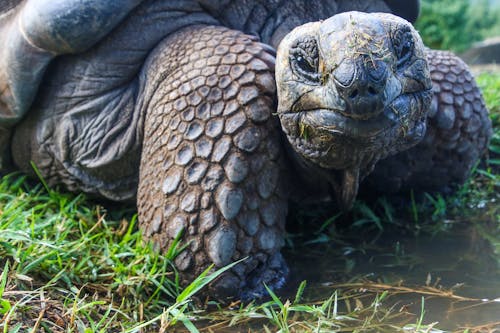To Live Longer, Healthier, And Happier Be More Like A Tortoise
Every year that you’re alive, your risk of dying increases by 10%. This starts out innocuously enough: In your 30s, your odds of death in any given year are less than one in 1,000. But compounding 10% per annum starts to add up frighteningly quickly: By age 90, if you’re lucky enough to make it that far, your odds of not making your 91st birthday are roughly one in six.

Cells in some animals resist aging far better than others. The tortoise and naked mole rats are among them.
Those of us who make it far enough expect to be confronted with frailty, disease and death caused by our bodies’ degeneration with time.
Though these wrinkly, lumbering beasts might not seem like ideal ambassadors for aging well, by the statistical definition of aging—how fast your risk of death increases with time—these tortoises hardly age at all.
This phenomenon is known as “negligible senescence.” Some kinds of salamanders and fish, tiny pond creatures called hydra, and burrow-dwelling rodents called naked mole-rats all have a risk of death unrelated to how long ago they were born. This often means that they live much longer than closely related species. Mice might live to 3 years old but naked mole-rats can survive into their 30s.
A secret of the tortoises’ longevity is that their cells can divide more than twice as many times as human cells before becoming aged or “senescent.” Naked mole-rats are more enigmatic, aging in similar ways to us at the microscopic level; other biological mechanisms appear to keep them healthy regardless. The crucial result is that these animals don’t just live a long time, but they do so in good health. You would be hard-pressed to tell which adult naked mole-rats are the oldies. They maintain everything from muscle mass to fertility until extreme old age, scurrying around fit and healthy and even reproducing.
Already, therapies to combat cell senescence—senolytics—are undergoing human trials. There are currently at least 20 startups trying to transfer senolytics from the lab to the clinic.
Aging causes 85% of deaths in the U.S. but receives just 6% of government health research funding—substantially less than research into diseases like cancer and Alzheimer’s that aging causes. The amount of funding for research into actually treating aging is even smaller, while treating the chronic diseases of aging is a huge component of health costs.
It would be nice to live to 90, disease free, with the same energy and stamina as someone 20.
I fear advances that keep people alive artificially, in pain, and unable to think clearly or move.



